The next-gen MacBook Pro with Retina Display Review
by Anand Lal Shimpi on June 23, 2012 4:14 AM EST- Posted in
- Mac
- Apple
- MacBook Pro
- Laptops
- Notebooks
Battery Life
For much of the past year I haven’t been pleased with just how good Apple’s caching has become both on OS X and iOS. Aggressively caching our test web pages produces artificially inflated battery life numbers and that’s no fun for anyone. I’m happy to say that I’ve fixed that problem with our OS X battery life tests.
The suite is completely redone although conceptually it’s quite similar to what I’ve run in the past. I have three separate workloads: light, medium and heavy, each one representing a different stress level on the machine and all three giving you a decent idea of the dynamic range of battery life you can expect from one of these notebooks. All three tests are run with the displays set to 100 nits (a little above the halfway brightness point on most MacBook Pros).
The light and medium suites are inherently related - they use the same workload and simply vary the aggressiveness of that workload. The light test hits four different websites every minute, pausing for nearly the entire time to simulate reading time. Flash is enabled and present on three of the sites. The long pause time between page loads is what really makes this a light test. Web browsing may be the medium for the test but if all you’re doing is typing, watching Twitter update and maybe lazily doing some other content consumption this is a good representation of the battery life you’ll see. It’s a great way of estimating battery life if you’re going to be using your notebook as a glorified typewriter (likely a conservative estimate for that usage model).
The medium test hits the same webpages (Flash and all) but far more aggressively. Here there’s less than 10 seconds of reading time before going onto the next page. It sounds like a small change but the impact on battery life is tremendous.
Both the light and medium tests are run in their default state with processor graphics enabled, as well as with the discrete GPU forced on. I run with the dGPU on as well because it’s far too often that a single application open in the background will fire up the dGPU and contribute to draining your battery. The goal here is to deliver useful numbers after all.
The final test is very similar to our old heavy multitasking battery life tests, but with some updates. Here I’m downloading large files at a constant 1MB/s from a dedicated server, while playing back a looped 1080p H.264 movie (the Skyfall trailer) all while running the medium battery life test. The end result is a workload that gives you a good idea of what a heavy multitasking usage model will do in terms of battery life. I’ve found that OS X tends to fire up the dGPU anyway while running this workload so I saw no reason to run a separate set of numbers for processor and discrete graphics.
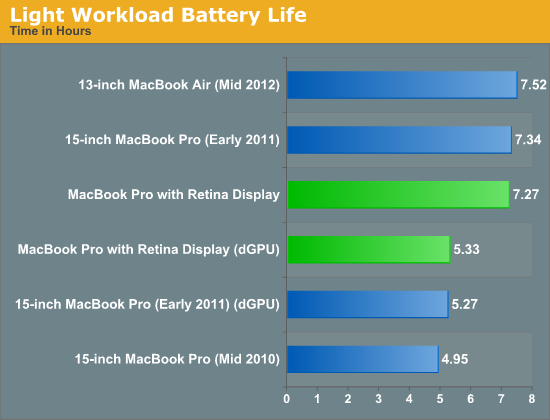
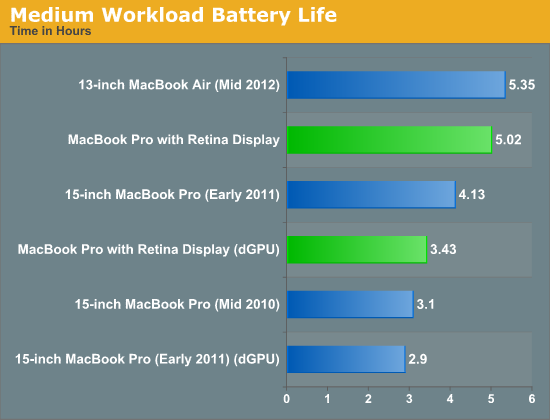
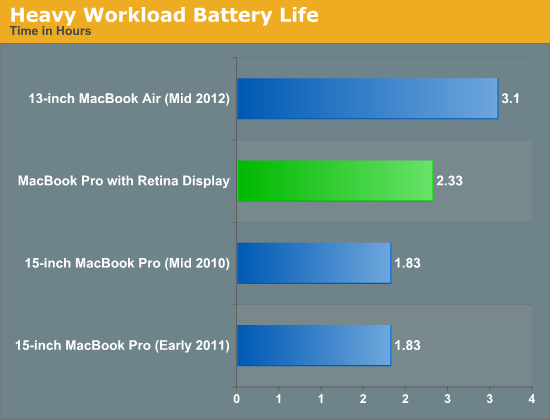
Overall the rMBP pretty much behaves as expected. Apple claims up to 7 hours of battery life and using our light workload we see a bit over that. Fire up the dGPU and even a light workload will get cut down to around 5.5 hours. Moderate usage will drop battery life to around 5 hours, and if you fire up the dGPU you’ll see that cut down to 3.5. The heavy multitaskers in the audience will see a bit above 2 hours out of a single charge. Note that all of these numbers are at 100 nits, drive the 2880 x 1800 panel at its full brightness and you can expect a tangible reduction in battery life.
The rMBP’s integrated 95Wh battery is ginormous by today’s standards, but it’s really necessary to drive both the silicon and that impressive panel. Subjectively I did find the rMBP lasted longer than last year’s MacBook Pro, despite the similar max battery life ratings. My experiences were echoed by the results in our tests.
I suspect most users will see around 5 hours of battery life out of the system compared to a bit under 4 hours out of last year’s machine. At minimum brightness, typing a long document (similar to what I’m doing right now) you can significantly exceed Apple’s 7 hour estimate. As always it really depends on usage model. Professional users doing a lot of photo and video editing aren’t going to see anywhere near the max battery life, while the writers and general users will be quite happy.
One trick to maximizing battery life on light or moderate workloads is to keep an eye on what the discrete GPU is doing. I still find that OS X will wake up the discrete GPU far too frequently, even when in my opinion its services aren’t needed. As always I turn to Cody Krieger’s excellent gfxCardStatus app for keeping an eye on which GPU is driving the panel. The app has been updated and is now fully compatible with the rMBP.


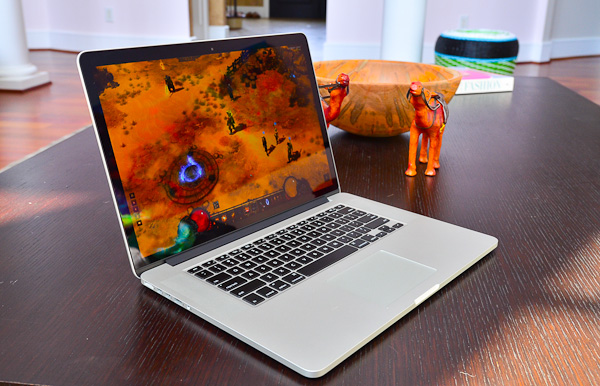
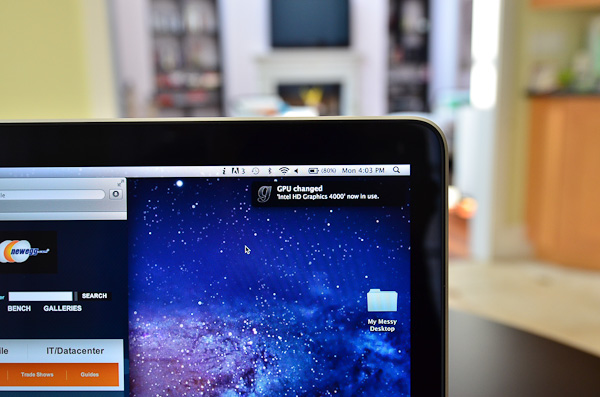








471 Comments
View All Comments
darkcrayon - Tuesday, June 26, 2012 - link
I hear you can work around that by not using that feature ;)Spunjji - Tuesday, June 26, 2012 - link
this is lost deep in the comments, so I doubt it will get any form of response. Nonetheless, while I feel this review has covered the ground incredibly well, there were some sever omissions that limit its usefulness.Where, for instance, are the comparisons to laptops that are not made by Apple? It's all well and good telling me that this laptop is cooler than its predecessor, but the trouble is that I didn't buy the 15" MBP because it turns into an unpleasantly hot and noisy beast as soon as you start gaming on it. Based on the surface temperatures you give, it sounds like this is no better with the new model *relative to non-Mac laptops* and yet I have no real way of knowing this for sure. I'd really appreciate that comparison - the same goes for battery life. In my case I currently use an Alienware M17x and would absolutely love to trade to something lighter with similar capabilities, but I need to know what the usability caveats will be.
I also feel that this site is asking us to take a lot on faith with regards to Thunderbolt. It's been a year and we can still only really attach storage to it outside of proprietary configurations, and even that doesn't work very well. We are also faced with the possibility that the first-gen tech will *never* work properly, yet it is still primarily mentioned as a good thing, with the rather horrible flaws pointed out deep within the bowls of a lengthy analysis.
flatform - Tuesday, June 26, 2012 - link
I am surprised not to see Anand commenting on the SEVERE problem that MOST users have with the Retina Displays -at least those mac users who are able to actually see a problem on their mac-. Advertising reasons maybe???Macbook Pro Retina -Plasma-TV-like(!!!!!)- Ghosting/Burn-in Issues
https://discussions.apple.com/thread/4034848?start...
IPad Retina issues: http://www.cultofmac.com/161495/new-ipads-retina-d...
Plus, the only reason for apple not to put gigabit is that the port did not fit in the new slimmer UPPER profile, not the case itself, it would had ruined their design lines, that is all!!!!! The 2012 Vaio Z is much slimmer but has a gigabit port, strangely implemented yet still there. Having worked for years with macs, we ALWAYS had the same problem, when you needed that adpter you had bought, it just wasn't -for any reason- there.... humiliating experience in front of clients...
having not normal SSD and especially no double slot configurable memory is probably just crap, 80% of laptops and desktops receive a hard drive and memory upgrade. just to shed off 100 Grams and 2mm of height?? 2009 Dell's Latitude Z600 was slimmer, 16inch displa, 2.0Kgs, yet had a normal hard drive and memory popped in.
Anand, with a 4 core/8 Thread Machine 16GB is BARELY enough TODAY, to work with Photoshop, Premiere, After FX and a RAW developer open, and still have free memory so that after fx can use all Threads. And That did not include one or 2 3D applications that a compositor would usually run. 16GB is the minimum, 32GB is the choice for the Video Professional. With so many programs switching to GPU processing, you should really be careful when commenting on the power of any machine with a dedicated graphic card.
For god's shake just wait and do not buy this crappy notebook. It is even more faulty than the first generation of 13inch Macbooks... wait at least 6 months for a proper revision, up to then Retina PC's will be available as well, with proper RETINA IPS displays with no burn-in issues and upgradeable parts.
darkcrayon - Tuesday, June 26, 2012 - link
I like how you mentioned the Vaio Z to bash the rMBP design, and then you went on to bash the rMBP for "limitations" that the Vaio Z also has (soldered RAM, though limited to 8GB, and more. Though off topic, your almost 3 month old iPad retina display problem is a nice touch, considering anyone with the problem could've gotten theres replaced for free. Please let us know which company is making millions of 260 ppi 10" screens with 100% perfect yields...flatform - Tuesday, June 26, 2012 - link
Comment on Vaio Z was just to point out stupid decisions who take into consideration only the looks of the machine, not direct comparison of the two machines, which are not comparable. Apple could have kept the same upper profile and diminish the lower bevel part. But it would not LOOK as thin. Let's see how professional Photographers -which i work with- will welcome the lack of FW800 and the need to echange 2-3 adapters to do one job, or the presence of only 2 USB's is a total failure when working in production environment. I am a professional industrial designer and compositor, believe me i would really like rMBP to serve me properly (i have been complaining about low-res screens since 2006) but it simply cannot. Replacing for free is the most logical thing to do and does not replace the evident problem. The iPAD is not of topic, it is a High PPI, same technology display which suffers from similar problems, just as the Macbook Display.My comment was that if Anandtech was serious about this review -respecting the readers that is- it SHOULD have mentioned -in a separate page with the fullest possible technical description- the problem in a clean and straightforward way, even if their sample did not have it (have they checked for it?)
When me moved from CRT's to TFT's (degrading our color reproduction, resolution and image quality) we did it because TFT;s had a hell less eyestrain, radiation, consumed less current and desk space. I cannot accepted that shedding off 150 grams (max) and 2mm of thickness from a WORKSTATION laptop is revolutionary and should force professionals to use adapters for the bluddy most used ports of their laptops, while depriving them from the most common upgrade in a notebook: memory and hard disk.
As for the last question, please let us know which company has developed the screen for apple and how many months later the same screen would be available in pc's as well.
Good thing Apple made the move, cause it has been FAR BEHIND in displays, (remember they where selling 1440x900 on 17" and 1280x800 on 15", then making it 1680x1050 and 1440x900 respectively, whereas a 1920x1200 15" screen was a common thing in mobile workstations) since they first brought a somewhat proper for graphic use display on their 2003 15" G4 Titanium. Workstation notebooks have IPS monitors for many years now.
robco - Tuesday, June 26, 2012 - link
Looking at the Googles, the news stories about the ghosting issues were posted today. Not something that likely would have been found before posting the review. This is a new display manufacturing process and there are going to be some mistakes. Never buy the first version, or at least the first production run, of any Apple product. This is one of the downsides to being an early adopter of almost any new technology. Apple tends to wait and collect data rather than acting rashly (see iPhone 4 fiasco). There isn't any data showing if this is a widespread problem, or only affecting a small percentage of units. But Apple will replace defective units.It took a little while, but third-party SSD upgrades are available for the MacBook Air. But on another note, would you expect *every* piece of equipment in your shop to be 100% user-upgradeable?
Everyone whined when Apple ditched floppies, serial, ADB and SCSI. There were adapters and people, well they adapted as well. I'm sure some will just buy a Thunderbolt dock (a couple are coming in a few months) and hook up all their peripherals and then connect them (as well as gigabit Ethernet) to the laptop with a single cable. Some folks may even be OK with trying desperately to live with only 16GB of non-upgradeable memory and have a bit more room in their bags and a bit less weight to schlep around.
But the beauty of the free market is that you get to vote with your pocketbook. If you're so terribly unhappy with the new rMBP, the old model, with new CPU and GPU upgrades) is still available. Show Apple your displeasure by sticking with the old design. Or by a fragile Sony laptop. Or a Dell Precision. Nobody is twisting your arm to make you buy this thing. Lots of other people will gladly accept the trade-offs and be happy with their lighter, thinner, quite powerful rMBPs...
flatform - Tuesday, June 26, 2012 - link
haha, good one "adapters that people adapted to" hahhaha. A good comment in general, covering most of the topics and dare i say most of the people in this page.wfolta - Tuesday, June 26, 2012 - link
I stopped reading when you said "most users have", which is obviously not true.flatform - Thursday, June 28, 2012 - link
Good thing to do, i am sure that made you wiser. Truth is a floating mean point of falsifications. (will not continue because you must have stopped reading already ;)pirloui - Thursday, June 28, 2012 - link
"SEVERE problem that MOST"That would rather be "some" and "some".